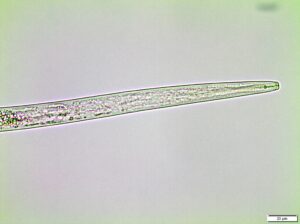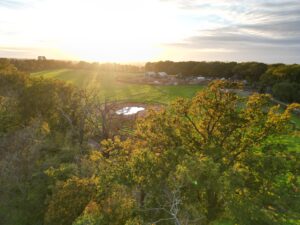Summary
Beech leaf disease threatens forests. New research studies management of this tree disease on a large scale to determine how to best protect the beech canopy and American forests.
Beech leaf disease (BLD) is a serious threat to beech trees. It impacts trees in urban and suburban landscapes as well as the beech forest as a whole. There are currently some very effective tools to manage BLD on specimen trees, landscape trees and trees in arboretums or parks. However, this is entirely different from managing the disease in a forest. Given the larger scale of a forest, it is difficult to treat every single tree. As such, disease management on this scale requires a different approach. Recently, scientists from The Bartlett Tree Research Laboratories initiated a five-year experiment to study forest level management of beech leaf disease.

What is beech leaf disease?

Microscopic roundworms called nematodes that feed on foliage cause beech leaf disease. All cultivars of American and European beech are susceptible. Infested trees weaken over time as the disease progresses.
Leaves of impacted beech trees have distinctive banding patterns between the leaf veins. Over time, the disease will cause malformed leaves that are almost leathery in texture. Eventually, buds will fail to leaf out and the canopy will start to thin.
Studying beech leaf disease treatments
The Bartlett Tree Research Laboratories has been researching BLD management since the early days of the disease’s discovery. Last year, the team announced two groundbreaking treatment strategies. The first is a foliar application for smaller trees. The second is a root flare injection suitable for large trees. These methods have proven effective in protecting valued trees in landscapes.
However, it’s very difficult to treat every single tree in acres and acres of forest. Further research presents an incredible opportunity to take a model from silviculture and see if it is possible to slow the disease down with integrative management approaches.
The goal of the current study is not to research complete eradication, but rather to find solutions to best manage the disease at a level at which the trees can again function as they need to function within a forest setting.
The research experiment
Bartlett’s scientists have established research plots at two sites: Pennypack Trust in Pennsylvania and Aquidneck Island Land Trust in Rhode Island. Both have forests extensively populated with beech trees. Further, leaf samples taken at the sites show evidence of the nematodes that cause beech leaf disease. Over the course of the next five years, researchers will evaluate three methods of disease management against a control group on these plots.
First, one management method borrowed from traditional forestry practices is called crown release. Select beech trees will be pruned to separate the crowns of the trees. This will create more light exposure. With the silvicultural approach, the hypothesis is that trees will grow at a faster rate and form a higher volume of wood. This may increase carbon storage and improve disease resilience. While the disease can still impact the trees, they may be able to deal with it better.
As part of this method, some understory and mid-story beech trees will also be removed. Disease progression in a forest starts with the understory. So, removing some trees will theoretically help remove the inoculum source for the disease.
The second management method being tested will be the use of a root flare injection treatment on select trees distributed throughout a research plot. Not every tree can be treated. So, by employing an effective treatment on a portion of the trees, will there be some level of slowing down disease progress?
Finally, a third method will combine crown release and selective removal along with the root flare injections.
The forest of the future
This research represents the first venture into forest level management of beech leaf disease. It examines not just beech trees, but also the other species in the plots to see how they respond to changing forest dynamics. The goal is not complete eradication of the disease, but rather long-term forest health.
Diverse forest stands are going to help slow the disease down. If some of the beech canopy can be retained while also allowing other species to establish as the next generation, it seems possible to create a more resilient forest overall.



